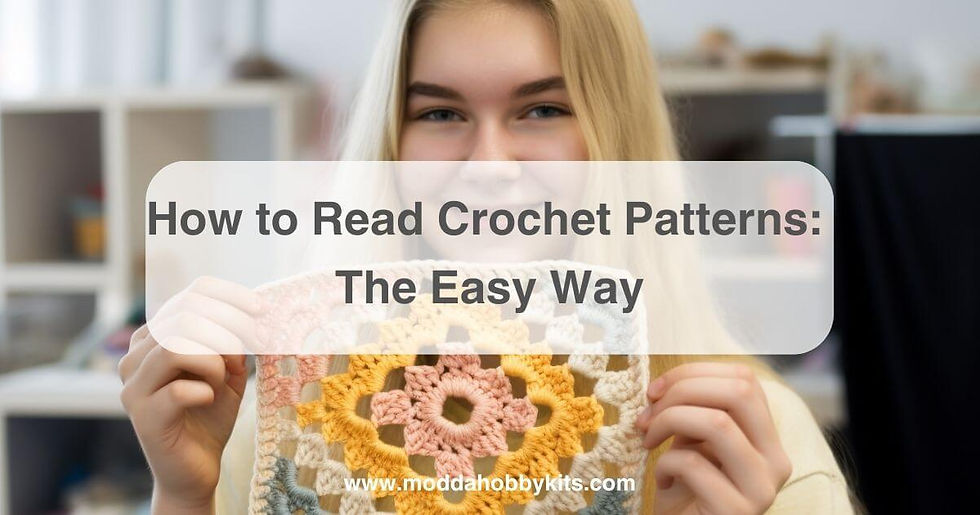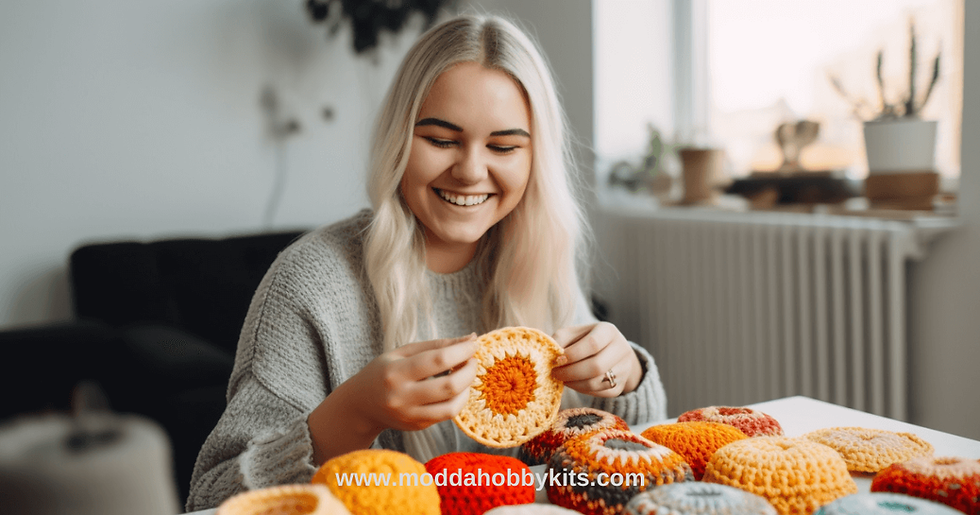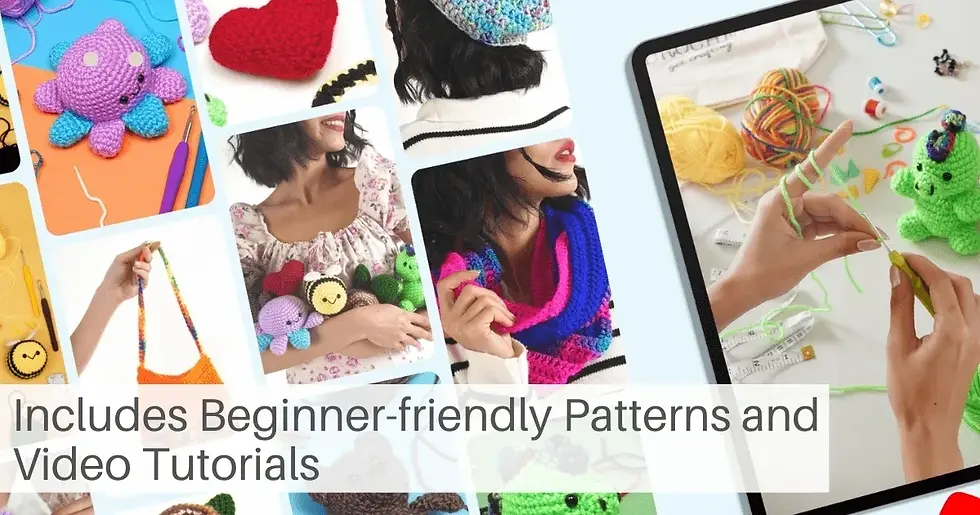How to Read Crochet Patterns: The Easy Way
- Erdem Gursoy
- May 8, 2023
- 10 min read

Are you ready to dive into the wonderful world of crochet but find yourself feeling overwhelmed by all those patterns?
Don't worry; we've got you covered!
In this blog post, we'll teach you how to read and understand crochet patterns like a pro.
From deciphering abbreviations and terminologies to reading symbol charts, we will explore various aspects that will help boost your confidence when tackling your next project.
Key Takeaways
Familiarize yourself with basic stitch abbreviations, special stitch notations, and pattern repeats to effectively read crochet patterns.
Learn how to decode written instructions and understand parentheses and brackets for repeating sections.
Understand chart symbols and identify stitch placement when reading crochet charts.
Utilize tools such as stitch markers, tally sheets, and row counters to keep track of rows and repeats while working on your project.
Understanding Crochet Pattern Terminologies
Identify basic stitch abbreviations and special stitch notations, while recognizing pattern repeats to effectively read crochet patterns.
Identifying Basic Stitch Abbreviations
Before diving into reading crochet patterns, it's crucial to familiarize yourself with the various basic stitch abbreviations used.
These abbreviations play a significant role in helping you understand the pattern and execute it accordingly.

Here are some of the most common stitch abbreviations you will encounter:
ch : chain
sl st : slip stitch
sc : single crochet
hdc : half double crochet
dc : double crochet
tr : treble crochet (also called triple crochet)
dtr : double treble crochet
inc : Increase (add one or more stitches)
dec : decrease (remove one or more stitches)
rep : repeat (follow the instruction/s again)
sk : skip (pass by one or more stitches)
sp(s) : space(s) (the gap between stitches)
st(s) : stitch(es) (the loops on your hook, where new loops are formed)
Keep in mind that these abbreviations may vary slightly depending on the author or publication of the pattern, so it is always advisable to reference the specific pattern's abbreviation key if provided.
Understanding these basic stitch abbreviations will make reading and following crochet patterns significantly easier, allowing you to create beautiful projects effortlessly!
Special Stitch Notations
Crochet patterns often include special stitch notations that are not used in basic crochet stitches.
These special stitches can add texture and unique details to any project. Here are some common special stitch notations you may come across:
Front post double crochet (FPdc) - This stitch is made by placing a double crochet around the post of the indicated stitch from the previous row, instead of into the top of the stitch.
Back post double crochet (BPdc) - Similar to FPdc, but worked around the back of the indicated stitch from the previous row.
Popcorn Stitch - A popcorn stitch is created by working multiple double crochets into one stitch, then dropping all but the last loop and pulling it through.
Cluster Stitch - A cluster is created by working several stitches together into one space or stitch on a previous row.
Shell Stitch - A shell consists of several stitches worked into one space or stitch on a previous row.
These special stitches may seem intimidating at first, but with practice and some guidance, they can really take your crochet projects to the next level!

Recognizing Pattern Repeats
One of the essential skills in reading crochet patterns is recognizing pattern repeats.
This involves identifying a sequence of stitches or sets of instructions that are repeated throughout the pattern.
Pattern repeats can save time and effort, as it eliminates the need to read through the same set of instructions over and over again.
To recognize pattern repeats, look for phrases like "repeat from * to *" or "work (set of stitches) X times."
It's also helpful to use stitch markers to keep track of where each repeat begins and ends.
How To Read Written Crochet Patterns
Decode stitch instructions and understand parentheses and brackets while following pattern repeats, whether you're working in rows or rounds - these are the core skills needed to read written crochet patterns.
Decoding Stitch Instructions
Decoding the stitch instructions in a crochet pattern is essential for understanding how to create the desired design. Here are some tips to help you decode stitch instructions:
Identify the abbreviation: Each stitch has its own abbreviation, which can be found in the pattern's abbreviation key. For example, SC stands for single crochet and DC stands for double crochet.
Determine when to use the abbreviated stitch: The pattern will indicate where to place each stitch by either specifying a specific number of stitches or using asterisks and hyphens to denote repeats.
Follow any special notations: Certain stitches may have additional notations that provide extra context, such as working around a previous stitch or working in back loops only.
Pay attention to parentheses and brackets: These symbols indicate groups of stitches that should be repeated or worked together.
Check for any variations or modifications: Some patterns may include variations on a particular stitch or modification suggestions based on personal preference.
By following these steps and taking the time to understand each stitch instruction, you'll be well on your way to creating beautiful crocheted pieces from even the most complex patterns.

Understanding Parentheses And Brackets
Parentheses and brackets are common punctuation used in crochet patterns to clarify the instructions.
Parentheses () are used to group a set of stitches together, while brackets [] indicate a stitch pattern that should be repeated multiple times.
For example, if a pattern instructs you to "work (2 sc, ch 1)" three times in parentheses, it means you should repeat the sequence of two single crochets and one chain stitch three times.
It's important to pay attention to how many repetitions are indicated within each set of parentheses or brackets when reading crochet patterns.
Missing or misinterpreting these instructions can lead to errors in your finished project.

Following Pattern Repeats
To successfully follow a crochet pattern, it's important to understand how repeats work.
Many patterns use repeated sections to create the design, which means you'll need to repeat certain stitches or combinations of stitches over and over again.
To avoid getting lost in the repetition, make sure you read and understand the repeat instructions carefully.
Let's say you're working on a blanket pattern that includes four rows of single crochet followed by two rows of double crochet.
The pattern may instruct you to "Repeat Rows 1-6 until piece measures desired length."
This means that after completing Row 2 (which is a row of single crochet), you'll start back at Row 1 and work through all six rows again before moving onto the next section of the pattern.
Remember that every pattern is different when it comes to repeating sections, so always check for additional instructions within parentheses or brackets if they appear in the repeat instructions.
Working In Rows Versus Rounds
Crochet patterns can be written in either rows or rounds, and it's important to understand the difference between them.
Rows are worked back and forth in a straight line, while rounds are worked in a circular motion.
Row patterns are often used for items such as scarves or blankets that need to have distinct beginning and ending edges.
When working with row patterns, it's crucial to keep track of which row you're on by counting each row as you complete it.
For round patterns, stitch markers can help you keep track of where each round begins and ends.
How To Read Crochet Symbol Charts
Learn how to decode the symbols in crochet charts and easily follow pattern repeats with our comprehensive guide.
Understanding Chart Symbols
Crochet charts provide a visual representation of the pattern, making it easier to understand.
Here are some symbols commonly found on crochet charts:
Solid filled square: represents a single crochet stitch.
Open square: represents a chain stitch.
X or cross: represents a double crochet stitch.
Circle: represents a slip stitch.
Arrowhead: represents a treble crochet stitch.
Slash or diagonal line: indicates where to place the hook for the next stitch.
It's important to note that different designers may use slightly different symbols on their charts, so it's always best to check the legend of each pattern before starting.

Additionally, it's essential to keep track of the number of stitches and rows in each section of the chart to ensure that you're staying on track with the pattern's instructions.
Remembering these chart symbols will be helpful when reading patterns for amigurumi animals or bigger projects such as sweaters and afghans.
Crochet charts are an excellent way to stay organized and avoid confusion while working through a pattern.
By taking time to learn how to read crochet charts correctly, you'll be able to take your crocheting skills to new heights!
Identifying Stitch Placement
Identifying stitch placement is crucial when reading crochet patterns, especially when working with charts.
Symbols on a chart represent each stitch and its specific location in the pattern.
For example, a blank square on the chart represents a chain space or skipped stitch, while an "x" symbol indicates that you need to make a stitch in that particular spot.
Pay close attention to where each symbol falls within the charted design to ensure your finished item matches the intended outcome.
Following Charted Repeats
Crochet pattern charts are a visual representation of the stitches and motifs used in a crochet project.
When reading charted repeats, it's important to understand the symbols used for each stitch and how they relate to one another.
The chart will typically indicate if you need to repeat a section of stitches multiple times or use different colors for specific sections.
It's also important to keep track of your progress when working from crochet charts by marking off completed rows and regularly checking that your work matches the design on the chart.
Utilizing stitch markers can be helpful as well, especially when working on more complicated patterns with many repeats.

Tips And Tricks For Reading Crochet Patterns
In this section, we'll share helpful tips for keeping track of rows and repeats, using stitch markers to stay organized, troubleshooting common mistakes, and utilizing resources for learning more about pattern reading - so you can tackle any crochet project with confidence!
Keep reading to become a pro at decoding crochet patterns.
Keeping Track Of Rows And Repeats
Keeping track of rows and repeats is essential when reading crochet patterns to ensure accuracy, especially for larger projects.
Here are some tips to help you keep track:
Use a stitch marker or a piece of contrasting yarn to mark the beginning of each round or row.
Keep a tally sheet or use a row counter app on your phone to count rows and pattern repeats.
Highlight or circle the specific row or rounds you are working on so that you can easily refer back to it.
Make notes directly on the pattern to remind yourself of any changes you made or areas that need improvement.
Don't be afraid to frog (undo) your work if necessary to correct mistakes.
By keeping track of your progress, you will have an easier time following the pattern and avoid making errors along the way.
This will also save you time from having to backtrack or start over completely. Remember, practice makes perfect, so don’t get discouraged if it takes some time to develop this skill!

Using Stitch Markers
Stitch markers are a useful tool when reading crochet patterns, especially when working on larger projects that require many stitches and rows.
They can help you keep track of your progress and ensure that you don't lose your place in the pattern.
Simply place a marker at key points in the pattern where increases or decreases occur, or where stitch counts need to be checked.
Stitch markers also come in handy when working with multiple colors or stitch patterns within one project.
By using different colored markers for each section of the pattern, it is easier to identify which stitches belong where when switching between sections.
Overall, utilizing stitch markers while reading crochet patterns helps prevent mistakes and makes crafting more efficient.
Troubleshooting Common Pattern Reading Mistakes
Crochet patterns can be complex and difficult to understand, especially for beginners.
Here are some common mistakes that may occur when reading a crochet pattern, along with tips on how to troubleshoot them:
Misreading stitches: This mistake happens when you misinterpret the written instructions or charts and end up using the wrong stitch. To avoid this error, double-check the abbreviation or symbol used in the pattern before starting.
Losing track of rows: It's easy to lose count of the number of rows you've completed, which can lead to uneven or incorrectly shaped items. Keep track of your progress by placing a stitch marker at the beginning of each row and counting as you go.
Misinterpreting repeat instructions: Repeat instructions are often used in crochet patterns to save space and simplify instructions. However, misunderstanding these instructions can cause confusion when working on a project. Take time to read through repeat instructions carefully before beginning.
Ignoring gauge: Gauge is essential for ensuring that your finished item turns out the correct size and shape. Make sure to check your gauge before beginning any project and adjust your hook size if necessary.
Using the wrong yarn weight: Using a different yarn weight than what is called for in the pattern can lead to unexpected results such as distorted shapes or uneven tension. Always use the recommended yarn weight for best results.
By taking care to avoid these common mistakes when reading crochet patterns, you'll be able to create beautiful projects with ease and confidence!
Utilizing Resources For Learning More About Pattern Reading
One of the best ways to improve your crochet pattern reading skills is to utilize available resources.
Here are some resources you can use:
YouTube tutorials: There are many video tutorials available online that show you how to read crochet patterns step by step. These tutorials can be especially helpful for visual learners.
Online courses: You can take an online course on a platform like Modda Free Crochet Video Course to learn more about reading crochet patterns. This course often includes detailed explanations and exercises.
Crochet forums and groups: Joining online communities that focus on crocheting can give you access to experienced crocheters who can help answer your questions about pattern reading.
Pattern books: There are many books available with detailed explanations, tips, and tricks on how to read crochet patterns. Look for books that cater to beginners if you're just starting out.
Practice patterns: Practicing with beginner-friendly patterns is a great way to improve your understanding of pattern reading in general.
By taking advantage of these resources, you'll be well-equipped to tackle even the most complex crochet patterns with ease!
Conclusion
Learning how to read crochet patterns can be a daunting task for beginners, but with the right tools and resources it can become a breeze.
Understanding the terminologies used in crochet patterns such as abbreviations and special stitch notations is crucial.
It's important to remember that there are multiple ways to view and interpret crochet instructions, either through written patterns or chart symbols.
Utilizing stitch markers and other tools can help keep track of rows and repeats, while troubleshooting common pattern reading mistakes.

FAQ
What are the basics of reading a crochet pattern?
A crochet pattern consists of written instructions that outline the sequence of stitches needed to create the desired design or project. Understanding basic abbreviations, symbols and chart keys is crucial when reading patterns.
How can I decipher complex stitch patterns in a crochet pattern?
Start by breaking down the stitch or sequence into smaller parts, like individual rows or sections, then compare them to similar stitches you already know how to do. Utilizing online tutorials, videos and other resources can also provide helpful guidance while learning new techniques.
What should I do if I encounter unfamiliar terms or abbreviations in a crochet pattern?
Fortunately there are many online resources available for researching unique terminology used within various patterns such as glossaries and dictionaries created specifically for crocheting enthusiasts. If you still have trouble decoding an abbreviation, try reaching out to fellow crafters on social media forums who may be able provide assistance.
Are there any shortcuts for reading complicated stitch designs within a crochet pattern?
One shortcut might be using specialized software programs that decode complicated charts and visually represent them as written instructions with color coding . Apps with built-in dictionary functions as well let you quickly look up unfamiliar terms without having stop working on your project & lose momentum





![How To End A Crochet Project [Video Tutorial]](https://static.wixstatic.com/media/4ce1a6_33b886f54ac24c77bf5ad91d58f8ef56~mv2.jpg/v1/fill/w_980,h_515,al_c,q_85,usm_0.66_1.00_0.01,enc_avif,quality_auto/4ce1a6_33b886f54ac24c77bf5ad91d58f8ef56~mv2.jpg)


Comments